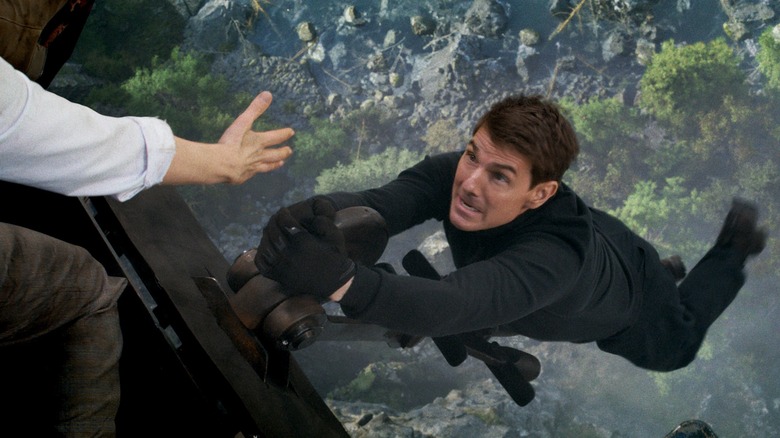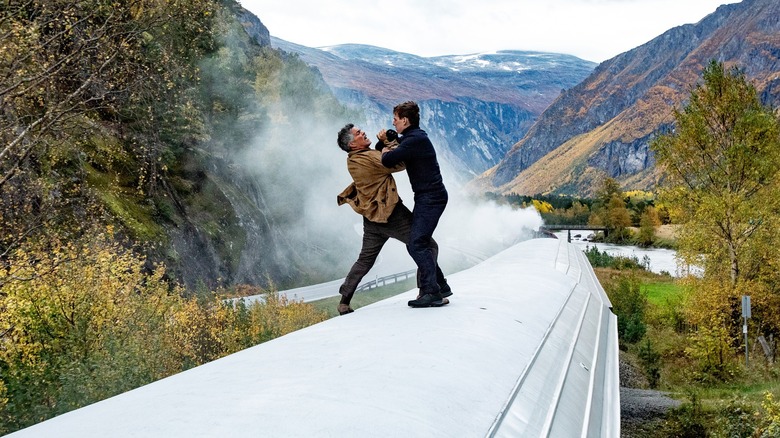Mission: Impossible Director Christopher McQuarrie Reveals Classic Movies That Inspired Dead Reckoning
When you watch the Tom Cruise-anchored "Mission: Impossible" films back-to-back, it's fascinating to see the franchise evolve from entry to entry. Whereas Brian De Palma's original 1996 film owes as much to Alfred Hitchcock's man-on-the-run thrillers as it does the '60s TV series that inspired it, John Woo's "Mission: Impossible II" is a kindred spirit to the Hong Kong filmmaker's gun-fu operas and bullet ballets.
After J.J. Abrams' more dramatic "Mission: Impossible III" became the lowest-grossing chapter in the series to date, Brad Bird's "Mission: Impossible — Ghost Protocol" ditched that film's idea of Cruise's Ethan Hunt enjoying a life of marital bliss in-between saving the world. Instead, it set him on the path to becoming something else entirely: a long-suffering silent-era comedy hero trapped in a modern action blockbuster arena.
Ever since Christopher McQuarrie took over, these films have only further cemented the idea that Ethan is indeed a 21st-century Buster Keaton archetype, risking life and limb time and time again (albeit deliberately and for a noble cause, as rarely was the case with Keaton's characters). That's not just yours truly flapping their gums, either.
During a Letterboxd video to promote "Mission: Impossible — Dead Reckoning Part One" (which Chris Evangelista reviewed for /Film), McQuarrie confirmed that he continues to mine inspiration from silent-era, slapstick and stunt-driven comedies. He admitted one particular Keaton staple heavily informs "Dead Reckoning":
"We start every single one of these movies going back to Harold Lloyd, Buster Keaton, Charlie Chaplin, and we look at 'Safety Last!,' 'Sherlock Jr.,' 'City Lights,' 'Modern Times.' 'The General' is the big one. If you watch 'The General,' you'll see that its influence on this movie, in particular, is absolutely evident. The fact that it's 100 years old and it's still regarded as one of the greatest films ever made is — that's another one that's high on the list of tonight's recommended viewing."
Filmmakers have always loved making trains go boom
That Christopher McQuarrie would cite "The General" as one of the films that inspired "Dead Reckoning Part One" should come as no surprise to those already familiar with Buster Keaton's 1926 comedy classic. Being very, very loosely based on the real-life historical Great Locomotive Chase (a military raid in which members of the Union Army wreaked havoc on a railway line vital to the Confederates during the U.S. Civil War), the centerpiece of the movie is an elaborate stunt involving a runaway locomotive and the collapse of a burning bridge. This was also clearly the genesis — or, at the very least, part of it — for "Dead Reckoning Part One" and its own massive practical train derailment.
Of course, if your intent is to make a multi-car train go boom real good, there are plenty of other excellent sources to borrow from besides "The General," with S. S. Rajamouli's "RRR" being one such recent example. In McQuarrie's case, he cited John Frankenheimer's classic 1964 WWII thriller "The Train" as a film he, Tom Cruise, and their many collaborators "studied extensively" while developing "Dead Reckoning Part One." Knowing what he knows now, however, McQuarrie admitted he can't even begin to imagine making that film the way Frankenheimer did in the pre-CGI era:
"I don't know how on Earth they ever made that movie. It's truly an extraordinary achievement. Having now done a train sequence, I — if you had handed me that script, I would have run screaming. It's incredible what they pulled off in that era with that technology. It's all practical. It has no CGI. There's multiple train wrecks that — it's the original 'Mission: Impossible.' It's really an incredible movie."
"Mission: Impossible — Dead Reckoning Part One" is now playing in theaters.

